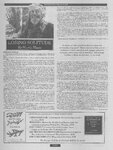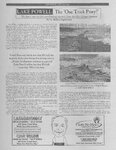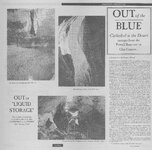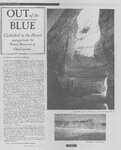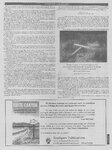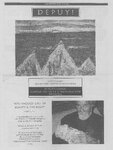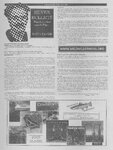| OCR Text |
Show SLL WHAT BuRec PLANNED From EDITOR’s NOTE: from its headwaters in the Rockies to the Gulf of California. Even the NPS was appalled by BuRec’s plans for parts of the Grand Canyon. Be sure to carefully study the map on the next page as well...The Zephyr will include more excerpts and maps in future issues...JS EFFECT OF THE PROPOSED in turn be dwarfed by the canyon. Though the dam would raise the water 672 feet to a maximum elevation of 1,876 feet above sea level, the multicolored canyon walls would tower more than 4,000 feet above the fiord-like lake. The quiet water of the lake thus created would extend upstream 93 miles to within a tenth of a mile of the mouth of Kanab Creek. At normal water surface elevation 1,866 feet, it would extend to within four-tenths of a mile of Kanab Creek. The minimum surface elevation of the reservoir would be 1,645 feet. Dam is proposed of power. primarily Coincidental with and Reservoir—The im- pounding of water behind Bridge Canyon Dam to an elevation of 1,876 feet probably would conceal few geological features that are unique or of special importance as documents of geological history. Any impoundment more than a few feet higher than would back water beyond otherwise largely be confined, and create a conspicuous, insistent intrusion into the broader PROPOSALS ent plans of the Bureau of Reclamation are carried through. Exceeding Hoover Dam in height, this Canyon Dam the upper reaches of the inner canyon to which it dom-visited western half of the Grand Canyon, the Bridge Canyon Dam may some day rise to the towering height of 740 feet above bedrock if the pres- the generation Canyon that elevation, however, Bridge Canyon Dam and Reservoir._Nineteen miles northwest of Peach Springs, Ariz., in the sel- would Canyon DAMS part of the canyon visible from the rim. There would result an artificial reservoir replacing the natural river in some of the most spectacular and characteristic views of the canyon obtainable. The great- est losses, insofar as geological features are concerned, would be in the area of volcanic activity at and westward from Toroweap Valley. Several features illustrating the early stages of canyon cutting and of local volcanism would be inundated. A SURVEY OF THE RECREATIONAL RESOURCES OF THE COLORADO RIVER BASIN for development and ‘river regulation. headwaters of the potential Bridge Canyon Reservoir at normal water surface rado River falls approximately elevation, the Colo- 1,260 feet. About 100 miles and 950 feet of the drop are within the boundaries of Grand Canyon National Park. To take advantage of this drop and yet avoid the construction of dams or other works in the park, the Bureau of Reclamation suggests a plan for diverting the Colorado River waters “not needed to maintain a steady stream for scenic purposes in the park” through a 44.8 mile tunnel from just above the east end of the park to a power plant on the Colorado River near the mouth of Kanab Creek. The capacity of the Kanab Tunnel would be 13,000 second feet. A 298-foot dam at the Marble Gorge site 15.5 miles upstream. from Nankoweap Canyon would divert water to the tunnel. Water released from the dam for scenic purposes in the park would pass through a power plant. The maximum and normal water surface tion of the Marble Gorge Reservoir would be feet, the elevation of the Colorado River Glen Canyon Dam site, and the minimum surface would be 3,115 feet above sea level. eleva3,125 at the water Kanab Tunnel and Power to divert the main flow of the Just above the Marble Gorge on the Colorado River near facilities Plant.—The proposal Colorado River from Dam to a power plant the mouth of Kanab Creek by means of a 44.8-mile tunnel under the Kaibab Plateau would be infinitely more serious in its effect upon Grand Canyon National Park than that resulting from the construction of Bridge Canyon Dam. According to the preliminary plans of the Bureau of Reclamation, the Kanab Power Plant would utilize for power generation most of the water available from the Colorado River in excess of the 1,000 second feet released through the Grand Canyon National Park, which is en- tirely inadequate for scenic purposes. The tunnel and power plant would be designed mum discharge of 13,000 second feet. for a maxi- The average discharge of the Colorado River at Angel Creek was 17,720 second feet for a of 19 years—1922-41. The maximum dis- proposed. This stringent limitation on the volume of water permitted to flow through Grand Canyon between Marble Gorge Dam and Kanab Creek would UNITED STATES DEPARTMENT OF THE INTERIOR NATIONAL PARK SERVICE This project is discussed in Chapter VIII—Canyon Lands of Southeastern Utah. In the 150 miles between the Glen Canyon Dam site and the estimated of recreational minimum flow in 1941 was 4,300 second feet (gage height 2.61 feet), more than four times the amount Marble Gorge Dam and Kanab Tunnel.—Following the Bridge Canyon, Coconino, and Bluff power suitable for development adjacent to the water. at the maximum was 29.25 feet and at the minimum —0.70 feet. (Reference Geological Survey Water-Supply Paper 929.) The 1,000 second feet which would be permitted to flow through the national park section of the Grand Ganyon under the plan proposed would be only slightly more than the minimum flow of the past 23 years, and less than one-seventeenth of the average flow. The the Dam located 4.5 miles his dam would be for which extends upstream for a number of miles. Access to the reservoir from United States Highway 89 would be difficult, and there is little or no land charge during that period was 127,000 second feet and the minimum 700 second feet. The gage height essential to the life of the Bridge Canyon Reservoir. would be the Glen Canyon upstream from Lees Ferry., site and a high dam at the Glen Canyon site. The Glen Canyon site is in a deep, sheer-walled canyon Bright period construction of the Bridge Canyon Dam would be the construction of the Coconino Dam on the Little Colorado River 49 miles upstream from the Colorado River and the Bluff Dam on the San Juan River 132 miles upstream from its mouth. Both of these dams would serve as flood control and silt detention structures. The Bluff Reservoir also would regulate the flow of the San Juan as required by downstream power plants. These two dams are Projects in the Bureau’s schedule of development site, might be more suitable for recrea- tional development and use than a low dam at that Bridge would BUREAU OF RECLAMATION Bridge RIVER The following are excerpts from a remarkable document, ”A Study of the Recreational Resources of the Colorado River Basin,” published by the National Park Service in 1946. It reveals that at one point in the late 40s, the Bureau of Reclamation intended to dam almost every free-flowing mile of the Colorado River, dam for the COLORADO ‘A Study of the Recreational Resources of the Colorado River" by the National Park Service in 1946 Gorge Dam site is 15 miles upstream from Nankoweap Marble Gorge Dam.—The Marble Can- yon, the northeast corner of Grand Canyon National Park. Neither a low dam, as contemplated under the Bridge Canyon Route for diversion of water to central Arizona, nor a high dam, such as the one proposed under the Marble Gorge diversion route, would be particularly objectionable from the scenic and recreational viewpoint. In either case the part of the reservoir below Navajo Bridge would be confined in the deep narrow Marble Gorge. From Navajo Bridge to Lees Ferry the lake formed by the higher dam would cover the bottom lands between the Echo Cliffs on the east and the high, vermilion cliffs of the Paria Pla- teau on the west. This more open body of water would be very scenic and easily accessible from United States Highway 89 which crosses the Colorado River on Navajo Bridge. Considering only the recreational use of the proposed Marble Gorge Reservoir and the Glen Can-: yon Reservoir, a high dam at the Marble Gorge site, which would eliminate PAGE 20 a dam © at the Glen greatly alter the character of the river and natural conditions in the bottom of the canyon through Grand Canyon National Park, that portion of the Grand Canyon which has been set apart since 1908 for preservation of the noneconomic values of its “unique and inspiring scenery. With the construction and operation of the Kanab Tunnel and Power Plant, the Colorado no longer would be a great river grinding the Grand Canyon ever deeper, but a man-controlled stream which could be turned on and off at will. In this section of the Grand Canyon, contrasting sharply with the section of the canyon which would be inundated by the Bridge Canyon Reservoir, the river is visible from numerous points on the upper rim and well-used trails provide access to and along it. The Kanab Creek diversion proposal would, in effect, take away from the Grand Canyon the very agent that created it; the remaining trickle would be sham and mockery in comparison to the once great force that carved the canyon—the Colorado River. The natural river and its companion piece, the canyon, are vitally significant and interrelated elements of the whole which is Grand Canyon National Park. Without the normal flow of the river the significance and completeness of the park will be destroyed and the will of the people defeated in that the great spectacle of the Grand Canyon, as set aside by the Congress in the national park, to be preserved in its natural state for this and succeeding generations, will be seriously impaired. , |







